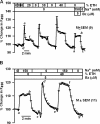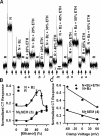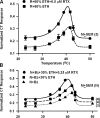Ethanol modulates the VR-1 variant amiloride-insensitive salt taste receptor. II. Effect on chorda tympani salt responses
- PMID: 15928404
- PMCID: PMC2234074
- DOI: 10.1085/jgp.200509264
Ethanol modulates the VR-1 variant amiloride-insensitive salt taste receptor. II. Effect on chorda tympani salt responses
Abstract
The effect of ethanol on the amiloride- and benzamil (Bz)-insensitive salt taste receptor was investigated by direct measurement of intracellular Na(+) activity ([Na(+)](i)) using fluorescence imaging in polarized fungiform taste receptor cells (TRCs) and by chorda tympani (CT) taste nerve recordings. CT responses to KCl and NaCl were recorded in Sprague-Dawley rats, and in wild-type (WT) and vanilloid receptor-1 (VR-1) knockout mice (KO). CT responses were monitored in the presence of Bz, a specific blocker of the epithelial Na(+) channel (ENaC). CT responses were also recorded in the presence of agonists (resiniferatoxin and elevated temperature) and antagonists (capsazepine and SB-366791) of VR-1 that similarly modulate the Bz-insensitive VR-1 variant salt taste receptor. In the absence of mineral salts, ethanol induced a transient decrease in TRC volume and elicited only transient phasic CT responses. In the presence of mineral salts, ethanol increased the apical cation flux in TRCs without a change in volume, increased transepithelial electrical resistance across the tongue, and elicited CT responses that were similar to salt responses, consisting of both a phasic component and a sustained tonic component. At concentrations <50%, ethanol enhanced responses to KCl and NaCl, while at ethanol concentrations >50%, those CT responses were inhibited. Resiniferatoxin and elevated temperature increased the sensitivity of the CT response to ethanol in salt-containing media, and SB-366791 inhibited the effect of ethanol, resiniferatoxin, and elevated temperature on the CT responses to mineral salts. VR-1 KO mice demonstrated no Bz-insensitive CT response to NaCl and no sensitivity to ethanol. We conclude that ethanol increases salt taste sensitivity by its direct action on the Bz-insensitive VR-1 variant salt taste receptor.
Figures










Comment in
-
The salty and burning taste of capsaicin.J Gen Physiol. 2005 Jun;125(6):531-4. doi: 10.1085/jgp.200509329. J Gen Physiol. 2005. PMID: 15928400 Free PMC article. No abstract available.
Similar articles
-
Ethanol modulates the VR-1 variant amiloride-insensitive salt taste receptor. I. Effect on TRC volume and Na+ flux.J Gen Physiol. 2005 Jun;125(6):569-85. doi: 10.1085/jgp.200409213. J Gen Physiol. 2005. PMID: 15928403 Free PMC article.
-
TRPM5-dependent amiloride- and benzamil-insensitive NaCl chorda tympani taste nerve response.Am J Physiol Gastrointest Liver Physiol. 2013 Jul 1;305(1):G106-17. doi: 10.1152/ajpgi.00053.2013. Epub 2013 May 2. Am J Physiol Gastrointest Liver Physiol. 2013. PMID: 23639808 Free PMC article.
-
The mammalian amiloride-insensitive non-specific salt taste receptor is a vanilloid receptor-1 variant.J Physiol. 2004 Jul 1;558(Pt 1):147-59. doi: 10.1113/jphysiol.2004.065656. Epub 2004 May 14. J Physiol. 2004. PMID: 15146042 Free PMC article.
-
Differential Effect of TRPV1 Modulators on Neural and Behavioral Responses to Taste Stimuli.Nutrients. 2024 Nov 12;16(22):3858. doi: 10.3390/nu16223858. Nutrients. 2024. PMID: 39599644 Free PMC article. Review.
-
Amiloride and vertebrate gustatory responses to NaCl.Neurosci Biobehav Rev. 1998;23(1):5-47. doi: 10.1016/s0149-7634(97)00063-8. Neurosci Biobehav Rev. 1998. PMID: 9861611 Review.
Cited by
-
A molecular perspective on identifying TRPV1 thermosensitive regions and disentangling polymodal activation.Temperature (Austin). 2021 Oct 26;10(1):67-101. doi: 10.1080/23328940.2021.1983354. eCollection 2023. Temperature (Austin). 2021. PMID: 37187836 Free PMC article. Review.
-
The Expression of Cannabinoid and Cannabinoid-Related Receptors on the Gustatory Cells of the Piglet Tongue.Molecules. 2024 Sep 28;29(19):4613. doi: 10.3390/molecules29194613. Molecules. 2024. PMID: 39407543 Free PMC article.
-
Strain differences in the neural, behavioral, and molecular correlates of sweet and salty taste in naive, ethanol- and sucrose-exposed P and NP rats.J Neurophysiol. 2011 Nov;106(5):2606-21. doi: 10.1152/jn.00196.2010. Epub 2011 Aug 17. J Neurophysiol. 2011. PMID: 21849614 Free PMC article.
-
Multisensory Processing of Gustatory Stimuli.Chemosens Percept. 2008 Jun;1(2):95-102. doi: 10.1007/s12078-008-9014-4. Chemosens Percept. 2008. PMID: 26322150 Free PMC article.
-
Selective activation of hTRPV1 by N-geranyl cyclopropylcarboxamide, an amiloride-insensitive salt taste enhancer.PLoS One. 2014 Feb 20;9(2):e89062. doi: 10.1371/journal.pone.0089062. eCollection 2014. PLoS One. 2014. PMID: 24586504 Free PMC article.
References
-
- Caterina, M.J., A. Leffler, A.B. Malmberg, W.J. Martin, J. Trafton, K.R. Petersen-Zeitz, M. Koltzenburg, A.I. Basbaum, and D. Julius. 2000. Impaired nociception and pain sensation in mice lacking the capsaicin receptor. Science. 288:306–313. - PubMed
-
- Danilova, V., and G. Hellekant. 2000. The taste of ethanol in a primate model. II. Glossopharyngeal nerve response in Macaca mulatta. Alcohol. 21:259–269. - PubMed
-
- Davis, J.B., D. Smart, and M.J. Gunthorpe. 2002. The vanilloid receptors and vanilloid receptor-like genes: a hot topic getting hotter. Cell Transmissions. 18:3–9.
-
- Diamant, H., M. Funakoshi, L. Strom, and Y. Zotterman. 1963. Electrophysiological studies on human taste nerves. Olfaction and Taste I. Y. Zotterman, editor. Pergamon Press, Oxford. 193–203.
-
- DeSimone, J.A., V. Lyall, G.L. Heck, T.H.T. Phan, R.I. Alam, G.M. Feldman, and R.M. Buch. 2001. A novel pharmacological probe links the amiloride-insensitive NaCl, KCl, and NH4Cl chorda tympani taste responses. J. Neurophysiol. 86:2638–2641. - PubMed
Publication types
MeSH terms
Substances
Grants and funding
LinkOut - more resources
Full Text Sources
Molecular Biology Databases
Research Materials

